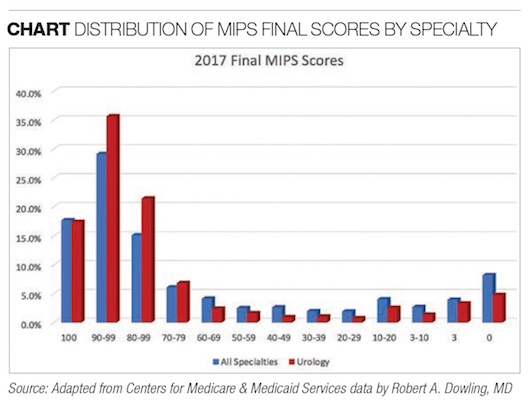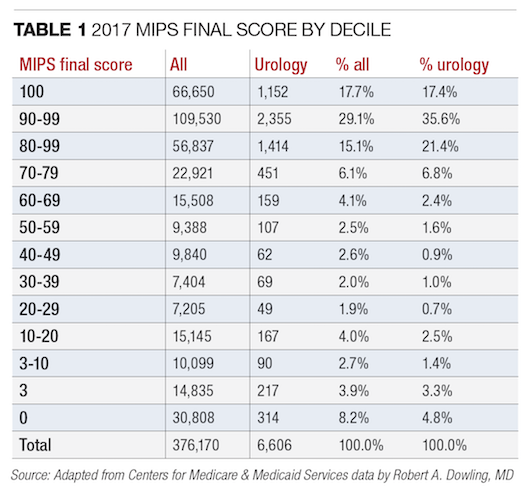Article
CMS releases MIPS data; how does urology measure up?
Author(s):
"The mean and median MIPS final composite scores among urologists in 2017 were 79.3 and 91.2, respectively; this was slightly higher than all specialties combined," writes Robert A. Dowling, MD.
ipopba - stock.adobe.com


Physician Compare is a website designed for stakeholders in the Medicare program first authorized by the Affordable Care Act in 2010 (bit.ly/PhysiciansCompareoverview). The purpose of the site is to make available to the public information on providers enrolled in the Medicare program, including but not limited to “quality” performance, patient experience measures, and utilization data.
The Medicare and CHIP Reauthorization Act of 2015 (MACRA) provided additional detail and authorization regarding the implementation and reporting of public data on Physician Compare. In this article, I will review the current status of Physician Compare and what urologists should understand about their public information.
The Physician Compare website homepage (www.medicare.gov/physiciancompare/) directs the user to a search engine based on information from Medicare’s Provider Enrollment, Chain, and Ownership System-essentially a database of providers and their affiliated organizations. The results page displays general information about the provider such as Medicare participation status, board certification, education, residency, group affiliations, hospital affiliations, electronic health record technology participation (MIPS Advancing Care Information [ACI] category), alternative payment model participation, and location information. If available, additional performance information is also displayed on this site.
Also by Dr. Dowling: How MIPS Cost category changes will affect urologists
According to CMS, performance information includes “star ratings,” which are in turn derived from a subset of Physician Quality Reporting System or MIPS Quality category measures in the following areas: Preventive care: General health, Preventive care: Cancer screening, Patient safety, Care planning, Diabetes, Heart disease, Respiratory diseases, and Behavioral health. Searching in 10 states for the specialty of urology, this author was unable to find any quality measures or MIPS participation measures (beyond EHR category) displayed for urologists on Physician Compare. Further information on displaying performance scores is available from CMS Webpage (bit.ly/performanceinformation).
In December 2019, CMS released the first downloadable database on Physician Compare based on the 2017 MIPS performance year (QPP year 1). The available datasets include a downloadable file of all individual clinicians, individual performance on a subset of quality measures, overall MIPS performance by category and final MIPS scores, and clinician utilization data. While this dataset is not in a form easily digested by the public, it contains individual level performance information on MIPS 2017 and foreshadows what information might be available in the future on the Physician Compare website.

The dataset includes information on approximately 1.1 million individual clinicians, 376,170 of whom have 2017 MIPS scores available (33%). According to CMS, MIPS scores are only available in the dataset on clinicians who are eligible to have a Physician Compare profile page. Among 83 individual specialties, 6,606 of 9,355 urologists (70.6%) have 2017 MIPS scores. The mean and median MIPS final composite scores among urologists in 2017 were 79.3 and 91.2, respectively; this was slightly higher than all specialties combined (mean: 70.7 and median: 88.3). 95.2% of urologists avoided a negative payment adjustment in 2019 based on 2017 scores (threshold of 3 points) compared to 91.8% of all specialties. See the graph and tables for the distribution of scores and statistics in 2017.
Why is this relevant? In 2022, the threshold for avoiding a negative payment adjustment in MIPS will be based upon either the actual mean or median of scores (regardless of specialty), so these 2017 data are informative and suggest urologists are doing better than average/better than median in the MIPS program overall.
Next:"The 2017 data also suggest that final score correlated most closely with performance in the Quality category"The 2017 data also suggest that final score correlated most closely with performance in the Quality category. This is not surprising for several reasons. First, the Quality category comprised 60% of the total score in year 1 of MIPS. Second, the Cost category-likely to show tremendous variability in performance-was waived in year 1. Third, the ACI category (now called Promoting Interoperability) included many bonus points allowing clinicians to exceed the maximum performance. Finally, the Improvement Activities category included enough options and exceptions to permit many clinicians to score perfectly.

As a result, the median scores for ACI and Improvement Activities were almost perfect (see table 2), and the Quality score is what ultimately determined the final score for the majority of clinicians. Subsequent years’ data may show different patterns or more variation as the weights of the Quality and Cost category grow closer, and there are fewer opportunities for bonus points in the ACI/PI category (harder to get a perfect score).

Bottom line: The initial details of MIPS 2017 are in and show urologists slightly outperforming the average in participation, overall scores, ACI and Improvement Activities category scores, and avoidance of a negative payment adjustment. While Physician Compare does not currently have MIPS performance data on many physicians, the website and availability of detailed data indicates capability and direction for the future. If you haven’t already done so, I recommend logging onto Physician Compare, checking your information, and correcting any missing or inaccurate information. In the future, this will be a robust portal for your Medicare patients to find you and learn about your practice.

















